window CHEVROLET S10 1995 2.G Owners Manual
[x] Cancel search | Manufacturer: CHEVROLET, Model Year: 1995, Model line: S10, Model: CHEVROLET S10 1995 2.GPages: 354, PDF Size: 18.92 MB
Page 28 of 354
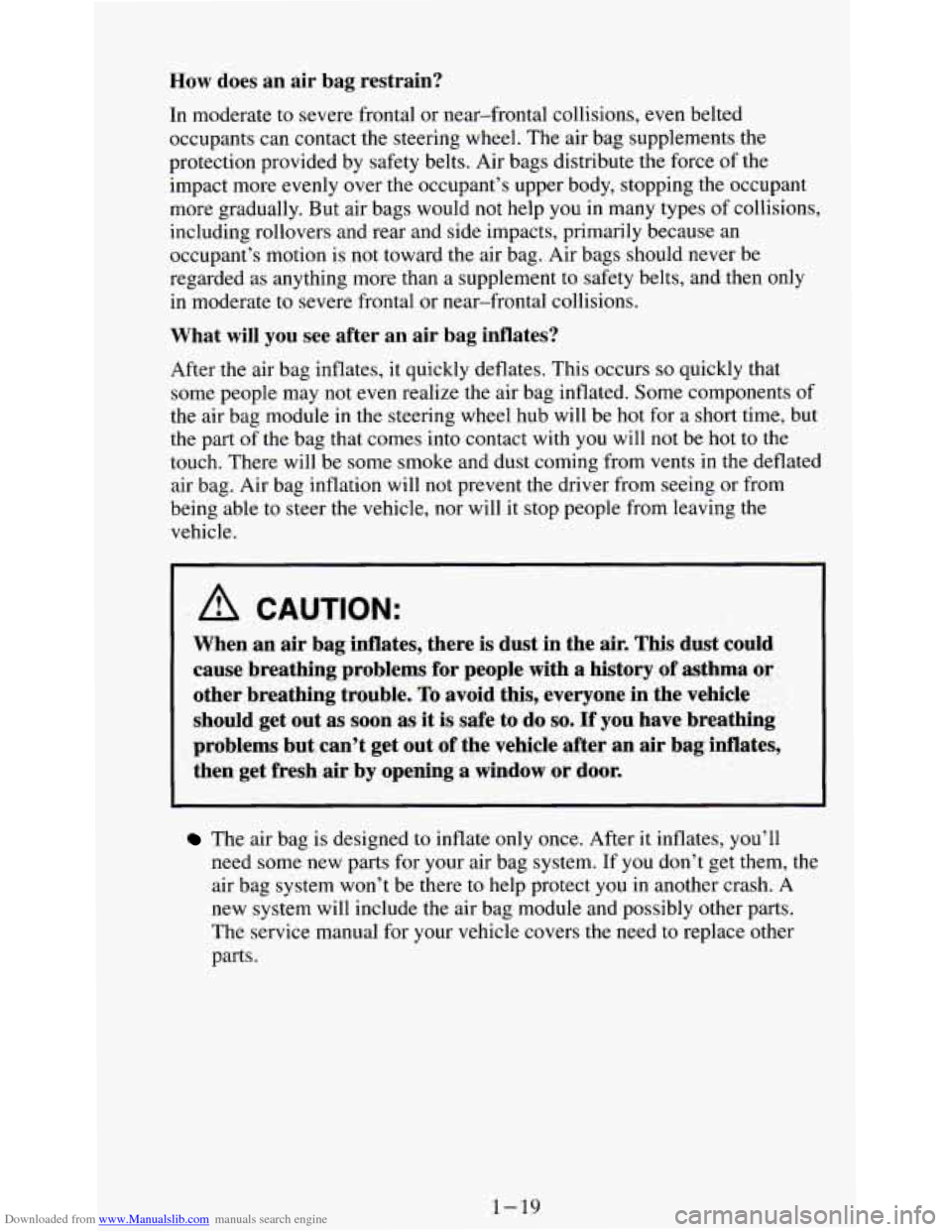
Downloaded from www.Manualslib.com manuals search engine How does an air bag restrain?
In moderate to severe frontal or near-frontal collisions, even belted
occupants can contact the steering wheel. The air bag supplements the
protection provided by safety belts. Air bags distribute the force of the
impact more evenly over the occupant’s upper body, stopping the occupant
more gradually. But air bags would
not help you in many types of collisions,
including rollovers and rear and side impacts, primarily because an
occupant’s motion is not toward the air bag. Air bags should never be
regarded as anything more than a supplement
to safety belts, and then only
in moderate to severe frontal or near-frontal collisions.
What will you see after an air bag inflates?
After the air bag inflates, it quickly deflates. This occurs so quickly that
some people may not even realize the air bag inflated. Some components
of
the air bag module in the steering wheel hub will be hot for a short time, but
the part
of the bag that comes into contact with you will not be hot to the
touch. There will be some smoke and dust coming from vents in the deflated
air bag. Air bag inflation will not prevent
the driver from seeing or from
being able
to steer the vehicle, nor will it stop people from leaving the
vehicle.
A CAUTION:
When an air bag inflates, there is dust in the air. This dust could
cause breathing problems for people with a history
of asthma or
other breathing trouble. To avoid this, everyone in the vehicle
should get out as soon as it is safe to do
so. If you have breathing
problems but can’t get out
of the vehicle after an air bag inflates,
then get fresh air by opening a window or door.
The air bag is designed to inflate only once. After it inflates, you’ll
need some new parts for your air bag system. If you don’t get them, the
air bag system won’t be there to help protect you in another crash. A
new system will include the air bag module and possibly other parts.
The service manual for your vehicle covers the need to replace other
parts.
1-19
Page 47 of 354
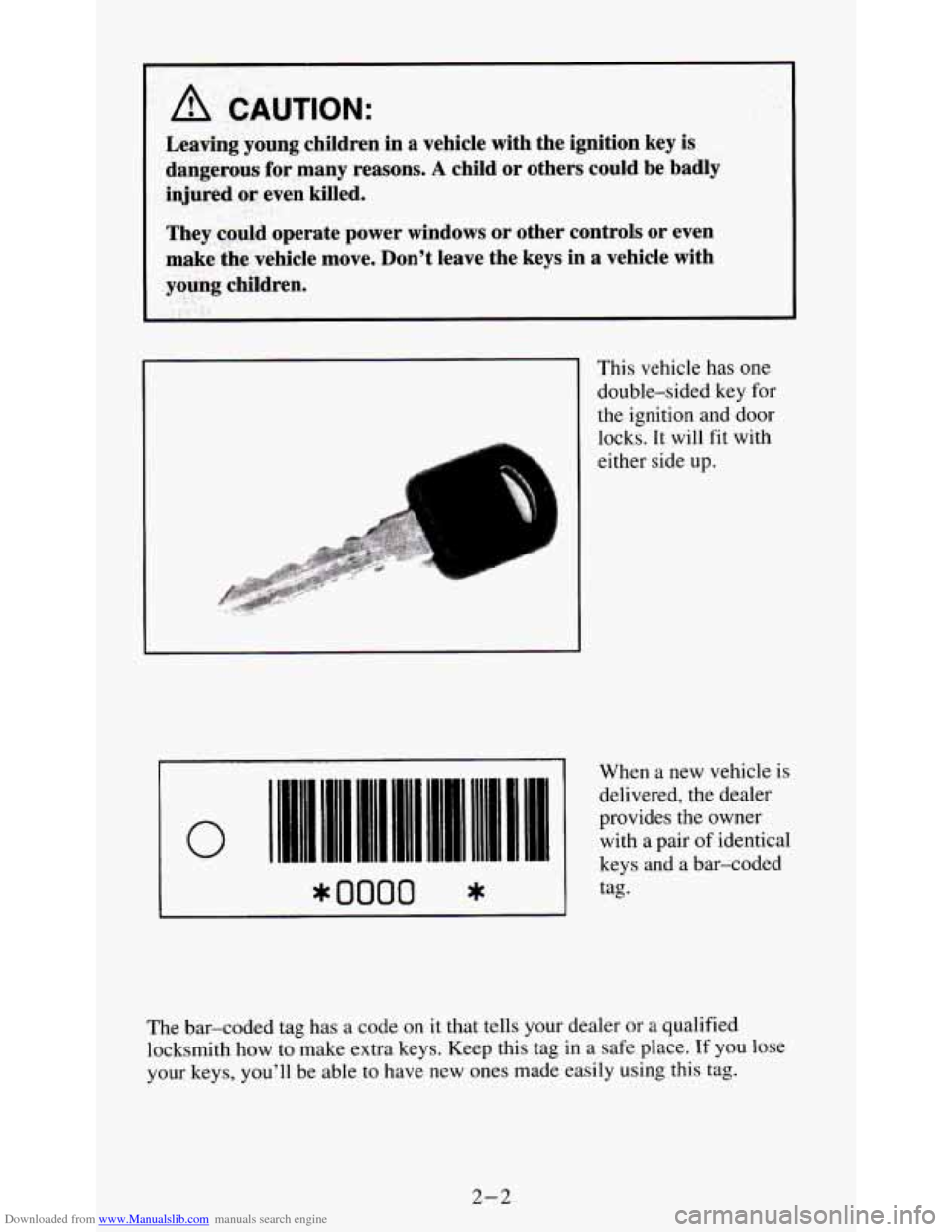
Downloaded from www.Manualslib.com manuals search engine A CAUTION:
Leaving young children in a vehicle with the ignition key is
dangerous for many reasons.
A child or others could be badly
injured
or even killed.
They could operate power windows or other controls or even
make the vehicle move. Don’t leave the keys in a vehicle w\
ith
young children.
This vehicle has one
double-sided key for
the ignition and door
locks. It will fit with
either side up.
iIIII Ill1
FMllM 11111 1111I 11111 IllUl 111111 II I1
I
When a new vehicle is
delivered, the dealer
provides the owner
with a pair of identical
keys and a bar-coded
0 11111 11111 11.11 .1..1 ,1111. .... I. I. .-
* 0000 *
The bar-coded tag has a code on it that tells your dealer or a qualified
locksmith how to make extra keys. Keep this tag
in a safe place. If you lose
your keys,
you’ll be able to have new ones made easily using this tag.
2-2
Page 54 of 354
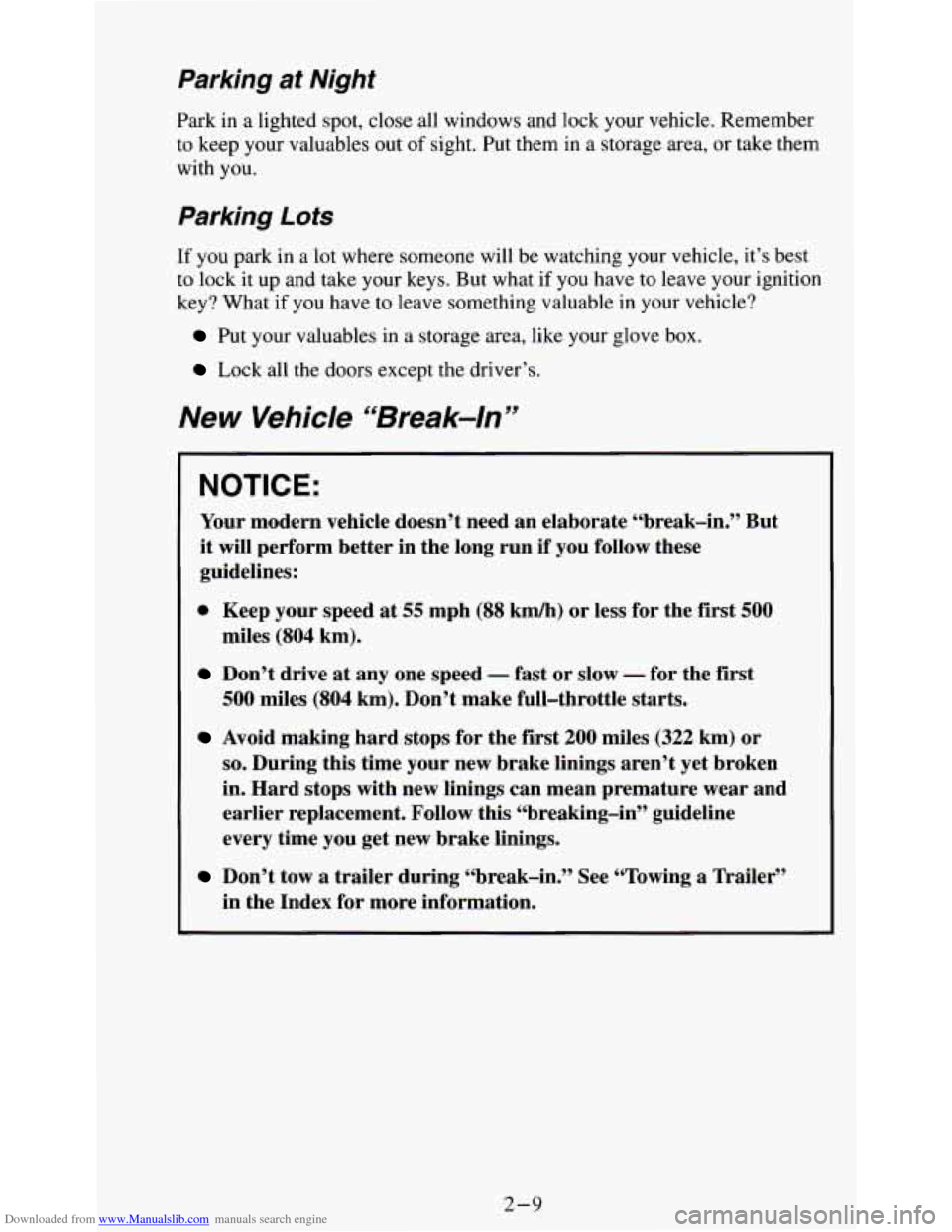
Downloaded from www.Manualslib.com manuals search engine Parking at Nlght
Park in a lighted spot, close all windows and lock your vehicle. Remember
to keep your valuables out
of sight. Put them in a storage area, or take them
with you.
Parking Lots
If you park in a lot where someone will be watching your vehicle, it’s best
to lock
it up and take your keys. But what if you have to leave your ignition
key? What
if you have to leave something valuable in your vehicle?
Put your valuables in a storage area, like your glove box.
Lock all the doors except the driver’s.
New Vehicle “Break-In”
NOTICE:
Your modern vehicle doesn’t need an elaborate “break-in.” But
it will perform better in the long run if you follow these
guidelines:
0 Keep your speed at 55 mph (88 km/h) or less for the first 500
miles (804 km).
Don’t drive at any one speed - fast or slow - for the first
500 miles (804 km). Don’t make full-throttle starts.
Avoid making hard stops for the first 200 miles (322 km) or
so. During this time your new brake linings aren’t yet broken
in. Hard stops with new linings can mean premature wear and
earlier replacement. Follow this “breaking-in” guideline
every time you get new brake linings.
Don’t tow a trailer during “break-in.” See “Towing a Trailer”
in the Index for more information.
2-9
Page 71 of 354
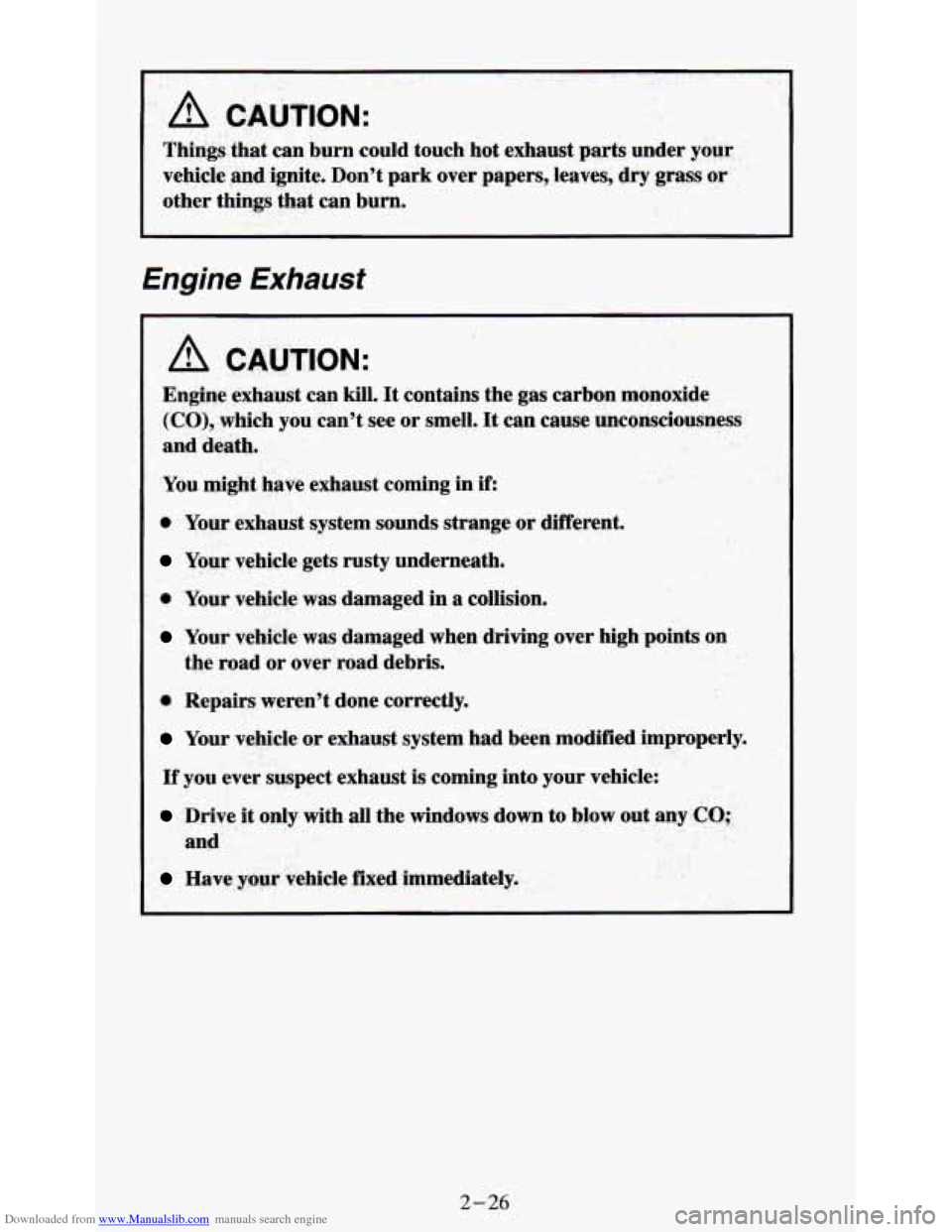
Downloaded from www.Manualslib.com manuals search engine Things that can burn could touch hot exhaust parts under your
vehicle and ignite. Don’t park over papers, leaves, dry grass
or
other things that can burn.
Engine Exhaust
A CAUTION:
Engine exhaust can kill. It contains the gas carbon monoxide
(CO), which you can’t see or smell. It can cause unconsciousness
and death.
You might have exhaust coming in
if:
0 Your exhaust system sounds strange or different.
Your vehicle gets rusty underneath.
0 Your vehicle was damaged in a collision.
Your vehicle was damaged when driving over high points on
the road or over road debris.
0 Repairs weren’t done correctly.
Your vehicle or exhaust system had been modified improperly.
If you ever suspect exhaust is coming into your vehicle:
Drive it only with all the windows down to blow out any CO;
and
Have your vehicle fixed immediately.
2-26
Page 77 of 354
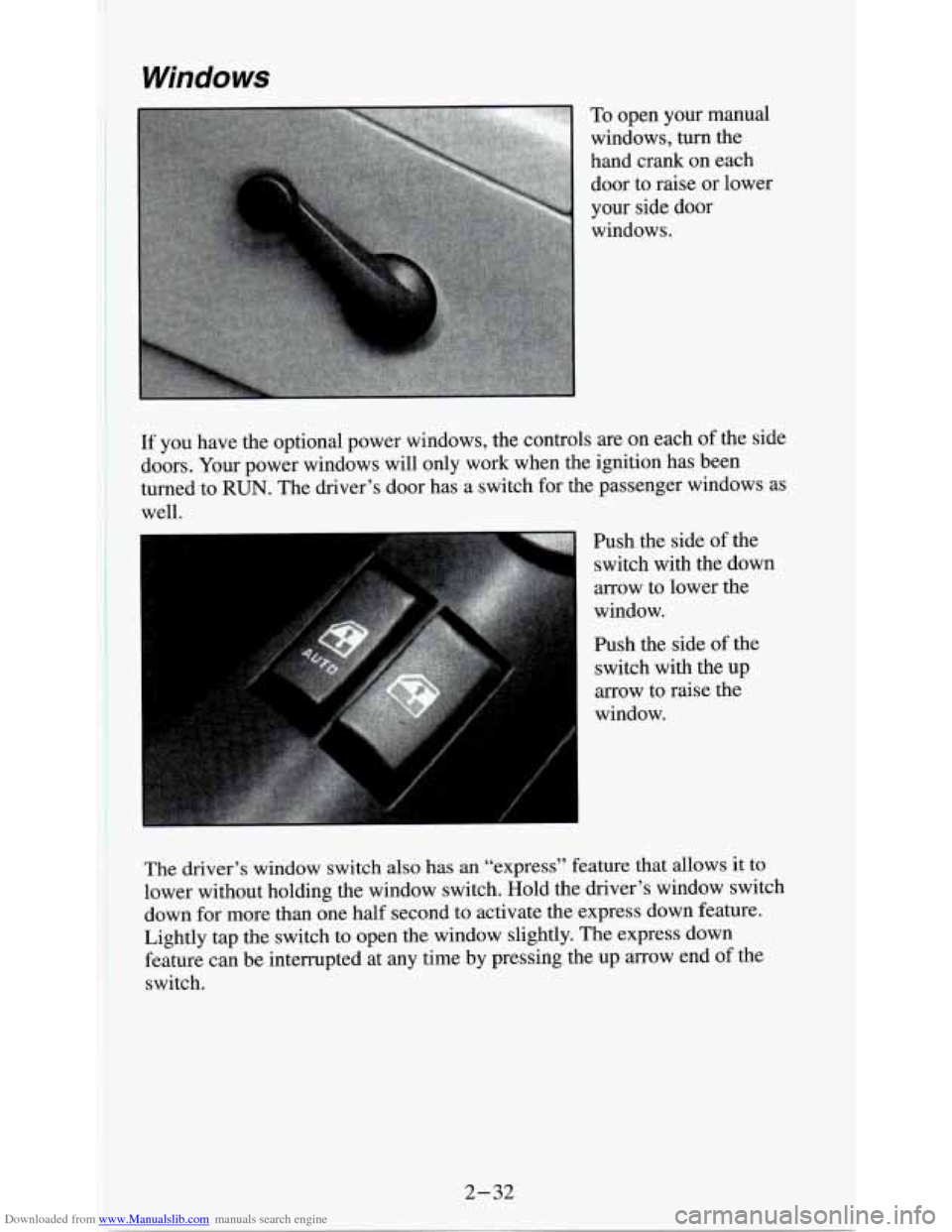
Downloaded from www.Manualslib.com manuals search engine Windows
To open your manual
windows, turn the
hand crank on each door to raise or lower
your side door windows.
Push the side of the
switch with the down
arrow to lower the
window.
Push the side of
the
switch with the up
arrow to raise the
window.
The driver’s window switch also has an “express” feature that allows
it to
lower without holding the window switch. Hold the driver’s window switch
down for more than one half second to activate the express down feature.
Lightly tap the switch
to open the window slightly. The express down
feature can be interrupted at any time by pressing the up arrow end of the
switch.
Page 78 of 354
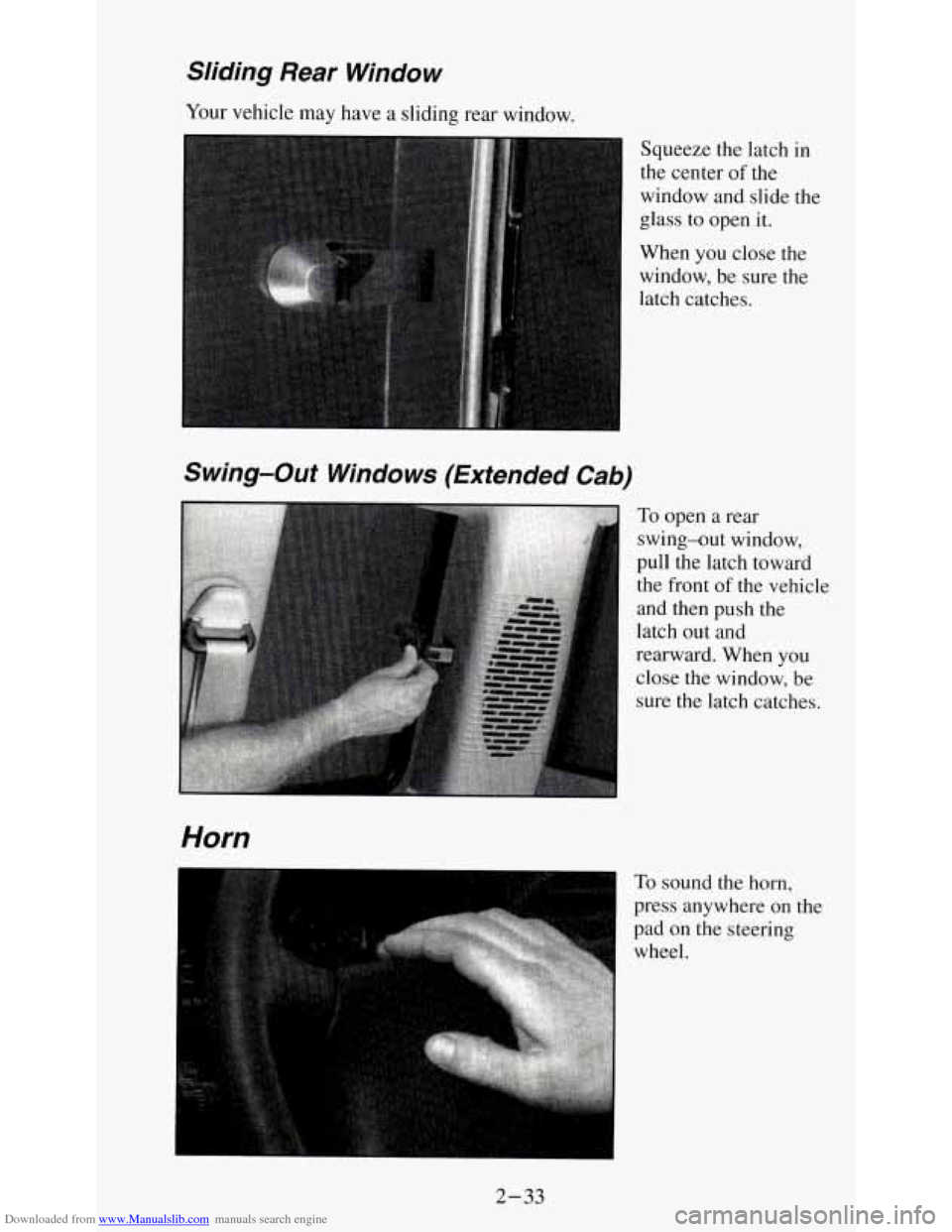
Downloaded from www.Manualslib.com manuals search engine Sliding Rear Window
Your vehicle may have a sliding rear window.
Squeeze the latch in
the center
of the
window and slide the
glass
to open it.
When you close the
window,
be sure the
latch catches.
Swing-Out Windows (Extended Cab)
To open a rear
swing-out window,
pull the latch toward
the front
of the vehicle
and then push the
latch out and
rearward. When you close the window, be
sure the latch catches.
Horn
' To sound the horn,
press anywhere on the
pad
on the steering
wheel.
2-33
Page 82 of 354
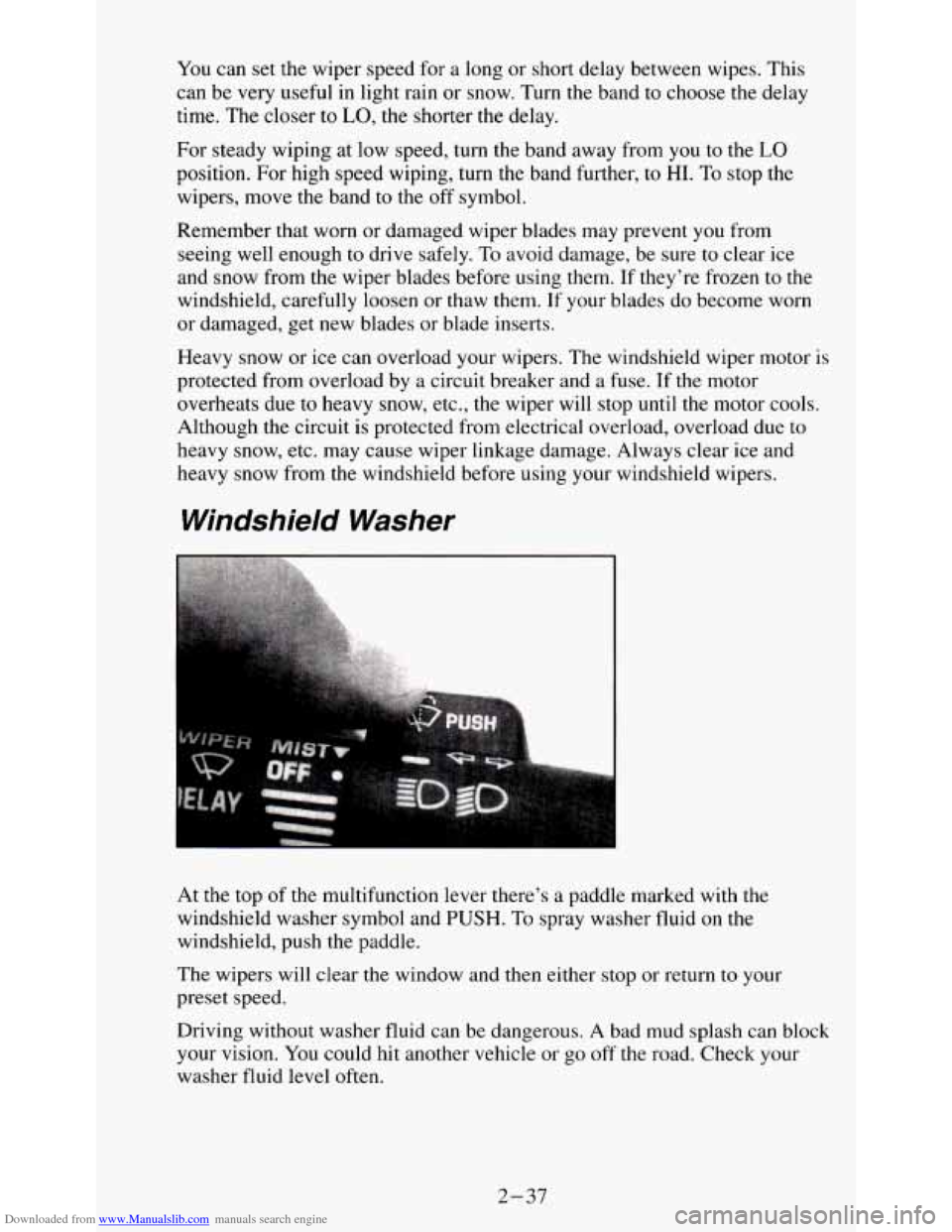
Downloaded from www.Manualslib.com manuals search engine You can set the wiper speed for a long or short delay between wipes. This
can be very useful in light rain or snow. Turn
the band to choose the delay
time. The closer
to LO, the shorter the delay.
For steady wiping at low speed, turn the band away from you to the
LO
position. For high speed wiping, turn the band further, to HI. To stop the
wipers, move the band to the
off symbol.
Remember that worn or damaged wiper blades may prevent
you from
seeing well enough to drive safely.
To avoid damage, be sure to clear ice
and snow from the wiper blades before using them. If they’re frozen to the
windshield, carefully loosen or thaw them. If your blades do become worn
or damaged, get new blades or blade inserts.
Heavy snow or ice can overload your wipers. The windshield wiper motor is
protected from overload by a circuit breaker and a fuse. If the motor
overheats due
to heavy snow, etc., the wiper will stop until the motor cools.
Although the circuit is protected from electrical overload, overload due to
heavy snow, etc. may cause wiper linkage damage. Always clear ice and
heavy snow from the windshield before using your windshield wipers.
Windshield Washer
At the top of the multifunction lever there’s a paddle marked with the
windshield washer symbol and
PUSH. To spray washer fluid on the
windshield, push the paddle.
The wipers will clear the window and then either stop or return
to your
preset speed.
Driving without washer fluid can be dangerous. A bad mud splash can block
your vision. You could hit another vehicle or go
off the road. Check your
washer fluid level often.
2-37
Page 112 of 354
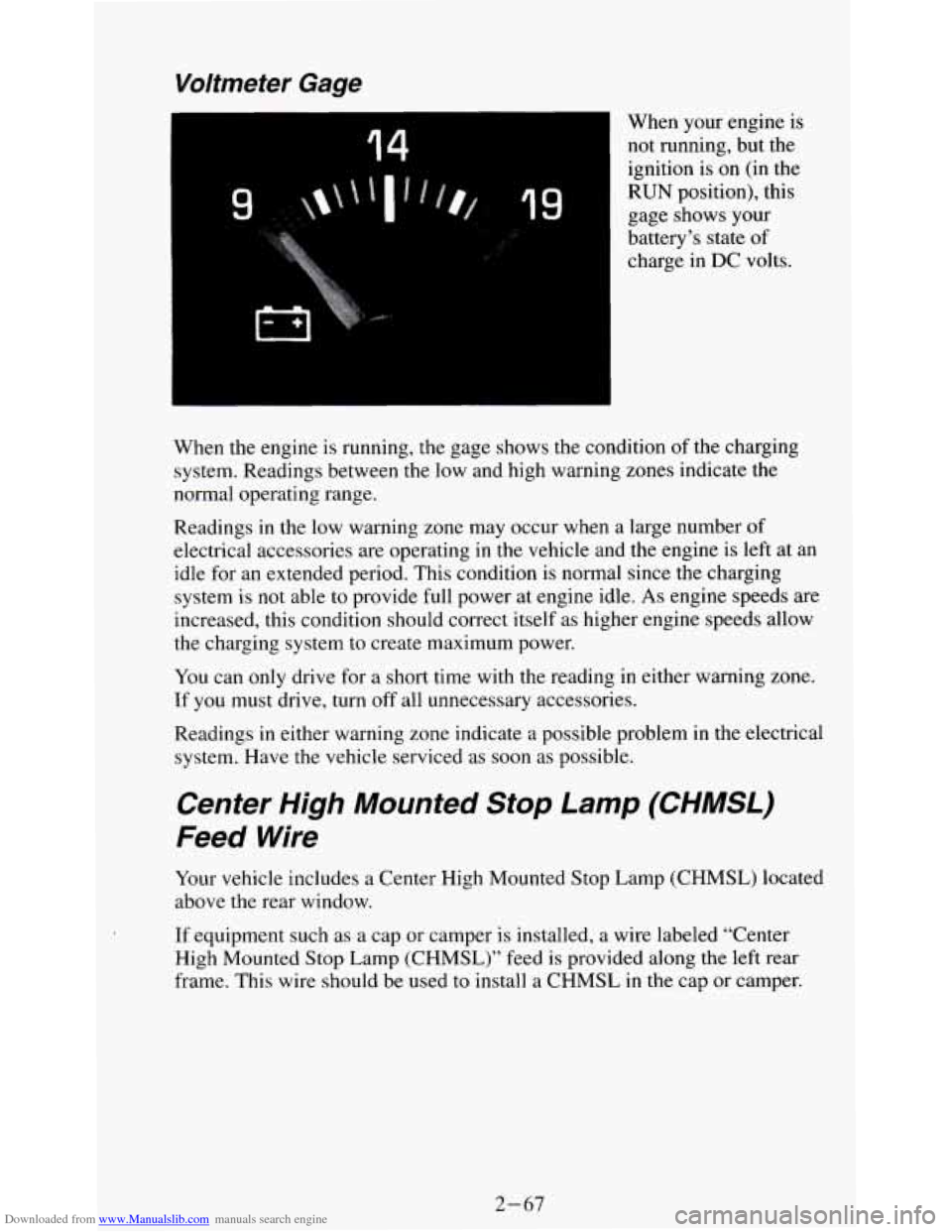
Downloaded from www.Manualslib.com manuals search engine Voltmeter Gage
14
9
When your engine is
not running, but the
ignition is
on (in the
RUN position), this
gage shows your
battery’s state
of
charge in DC volts.
When the engine is running, the gage shows
the condition of the charging
system. Readings between the low and high warning zones indicate the
normal operating range.
Readings in the low warning zone may occur when a large number
of
electrical accessories are operating in the vehicle and the engine is left at an
idle
for an extended period. This condition is normal since the charging
system is not able
to provide full power at engine idle. As engine speeds are
increased, this condition should correct itself as higher engine speeds allow
the charging system to create maximum power.
You can only drive for a short time with the reading
in either warning zone.
If you must drive, turn off all unnecessary accessories.
Readings
in either warning zone indicate a possible problem in the electrical
system. Have the vehicle serviced as soon
as possible.
Center High Mounted Stop Lamp (CHMSL)
Feed Wire
Your vehicle includes a Center High Mounted Stop Lamp (CHMSL) located
above the rear window.
If equipment such as a cap or camper is installed, a wire labeled “Center
High Mounted
Stop Lamp (CHMSL)” feed is provided along the left rear
frame.
This wire should be used to install a CHMSL in the cap or camper.
2-67
Page 115 of 354
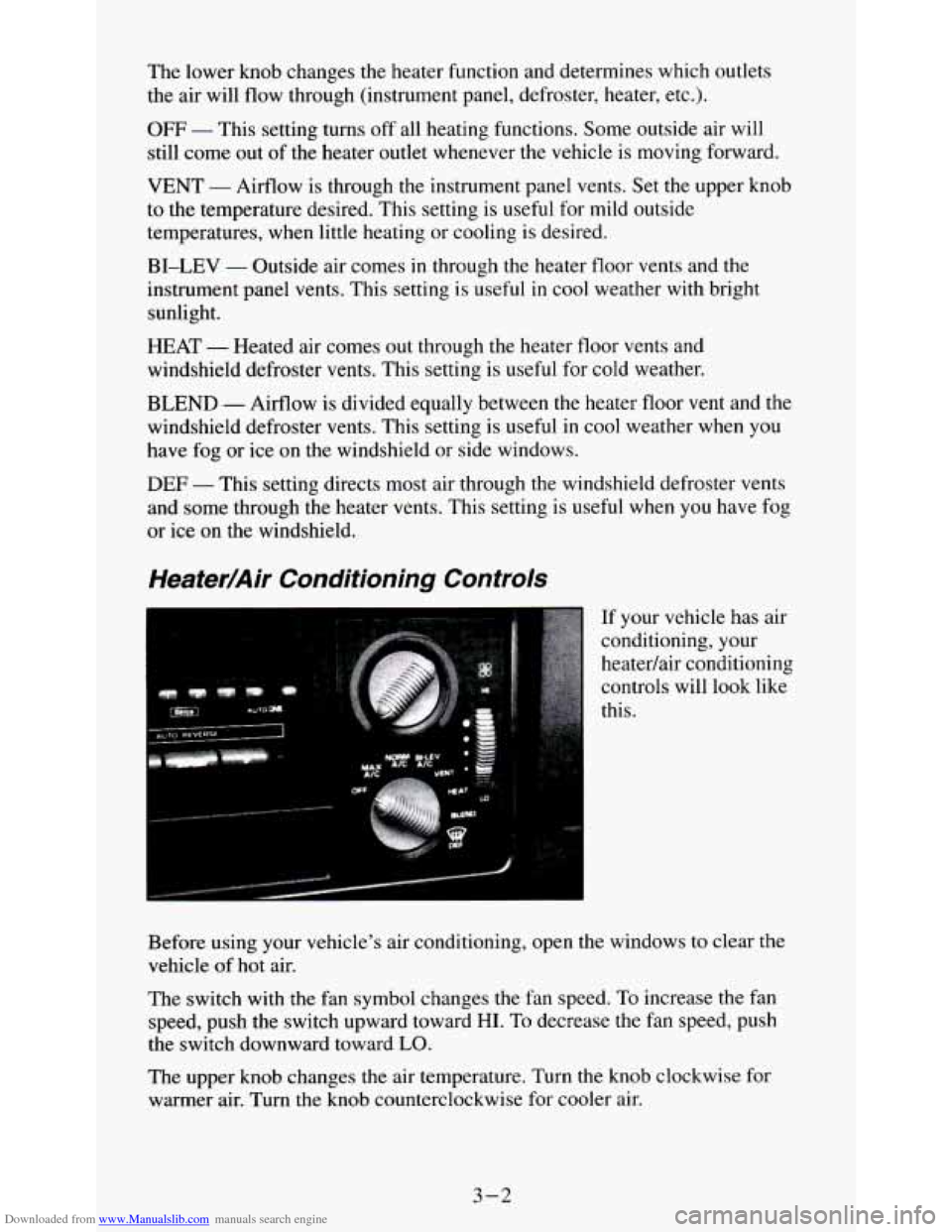
Downloaded from www.Manualslib.com manuals search engine The lower knob changes the heater function and determines which outlets
the air will flow through (instrument panel, defroster, heater, etc.).
OFF - This setting turns off all heating functions. Some outside air will
still come out of the heater outlet whenever the vehicle is moving forward.
VENT - Airflow is through the instrument panel vents. Set the upper knob
to the temperature desired. This setting is useful for mild outside
temperatures, when little heating or cooling is desired.
BI-LEV - Outside air comes in through the heater floor vents and the
instrument panel vents. This setting is useful
in cool weather with bright
sunlight.
HEAT
- Heated air comes out through the heater floor vents and
windshield defroster vents. This setting is useful for cold weather.
BLEND - Airflow is divided equally between the heater floor vent and the
windshield defroster vents. This setting is useful
in cool weather when you
have fog
or ice on the windshield or side windows.
DEF - This setting directs most air through the windshield defroster vents
and some through the heater vents. This setting
is useful when you have fog
or ice on the windshield.
Heater/Air Conditioning Controls
If your vehicle has air
conditioning, your
heatedair conditioning
controls will look like
this.
Before using your vehicle's air conditioning, open the windows to clear the
vehicle of
hot air.
The switch with the fan symbol changes the fan speed. To increase the fan
speed, push the switch upward toward
HI. To decrease the fan speed, push
the switch downward toward
LO.
The upper knob changes the air temperature. Turn the knob clockwise for
warmer air. Turn the knob counterclockwise for cooler air.
3-2
Page 116 of 354
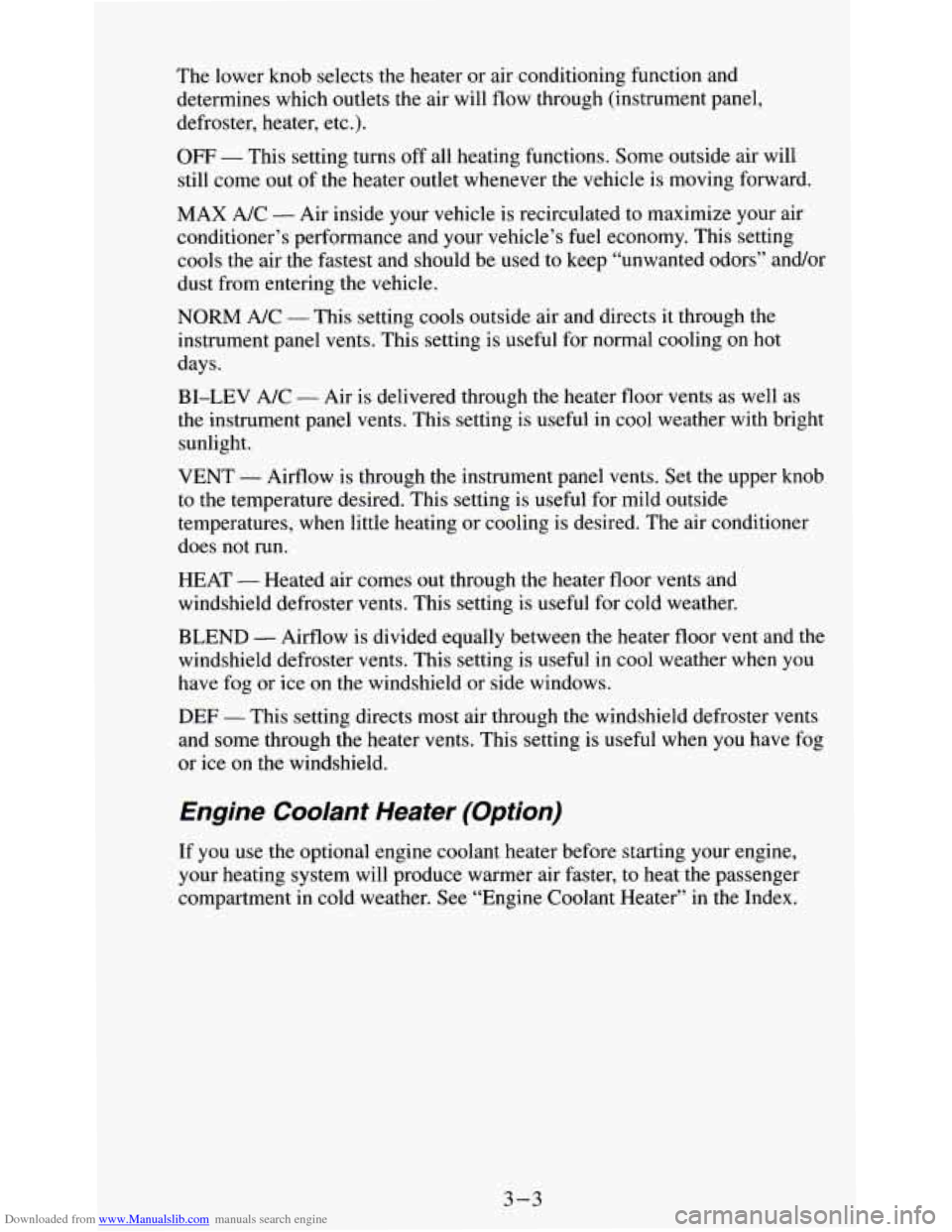
Downloaded from www.Manualslib.com manuals search engine The lower knob selects the heater or air conditioning function and
determines which outlets the air will flow through (instrument panel,
defroster, heater, etc.).
OFF - This setting turns off all heating functions. Some outside air will
still come out of the heater outlet whenever the vehicle is moving forward.
MAX A/C
- Air inside your vehicle is recirculated to maximize your air
conditioner’s performance and your vehicle’s fuel economy. This setting
cools the air the fastest and should be used to keep “unwanted odors” and/or
dust from entering the vehicle.
NORM A/C - This setting cools outside air and directs it through the
instrument panel vents. This setting is useful for normal cooling on hot
days.
BI-LEV A/C
- Air is delivered through the heater floor vents as well as
the instrument panel vents. This setting is useful in cool weather with bright
sunlight.
VENT - Airflow is through the instrument panel vents. Set the upper knob
to the temperature desired. This setting is useful for mild outside
temperatures, when little heating or cooling is desired. The air conditioner
does not run.
HEAT
- Heated air comes out through the heater floor vents and
windshield defroster vents. This setting is useful for cold weather.
BLEND
- Airflow is divided equally between the heater floor vent and the
windshield defroster vents. This setting
is useful in cool weather when you
have fog or ice on the windshield
or side windows.
DEF - This setting directs most air through the windshield defroster vents
and some through the heater vents. This setting is useful when you have fog
or ice on the windshield.
Engine Coolant Heater (Option)
If you use the optional engine coolant heater before starting your engine,
your heating system
will produce warmer air faster, to heat the passenger
compartment
in cold weather. See “Engine Coolant Heater” in the Index.
3-3